- GreenMatch
- Blog
- Environmental Impact of Orbeez
Are Orbeez Bad For The Environment? Statistics, Trends, Facts and Quotes

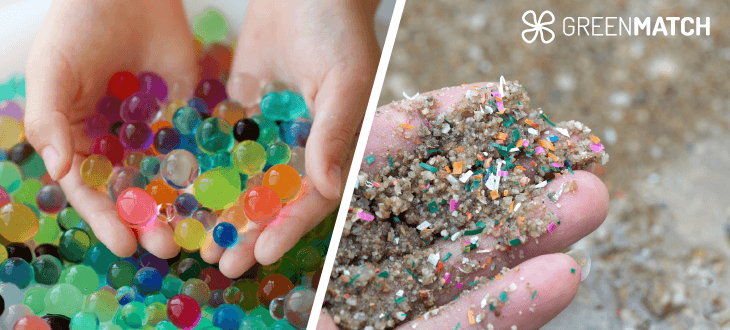
Orbeez (also known as water beads) are tiny, colourful, squishy beads that expand in water. They are fun and magical for kids and adults alike! But, beneath their vibrant and enticing exterior, questions about their environmental impact have been raised.
Water beads are primarily composed of a superabsorbent material known as sodium polyacrylate (Na-PA) and were initially designed to retain water in the soil for agricultural purposes. However, their appealing texture has seen them repurposed into colourful toys and educational tools for children.
Despite their widespread fandom, recent studies have shed light on the potential hazards posed by Orbeez. From the production of absorbent polymers, which involves fossil-based components, to serious threats to wildlife, as beads find their way into water bodies and can be ingested by animals.
To fully understand the impact of Orbeez, it's essential to consider the full lifecycle of these products and their uses. In this article, we will explore the latest scientific research, expert opinions, and available data to understand the true environmental cost of Orbeez.
- What do we mean by Orbeez exactly?
- Environmental impact of Orbeez
- What are Orbeez made of?
- Ecological impact
- Are Orbeez biodegradable?
- Are Obeez made from plastic?
- Are Orbeez Sustainable?
- Are Orbeez a health risk?
- Are Orbeez toxic?
- Can you recycle Orbeez?
- Can you get rid of Orbeez?
- What are Orbeez alternatives?
- Statistics, facts and figures about Orbeez
- Frequently asked questions about Orbeez
What do we mean by Orbeez exactly?
Orbeez are a brand of small, hard pellets that, when soaked in water, swell up to several times their original size, transforming into squishy, colourful spheres. Made from a superabsorbent polymer (SAP), typically sodium polyacrylate (Na-PA), this material can absorb and retain extremely large amounts of a liquid relative to its mass.
They were originally developed to help soil retain moisture for plants, but the unique properties of these polymers quickly found their way into consumer products.
Due to their ability to grow in water and pleasant tactile sensation, Orbeez are now used in decorative and educational activities, as stress-relief tools, and even in sensory play, which can benefit child development.
This growth in popularity, however, has also given rise to concerns about the environmental impact of these tiny water-absorbing beads. Prompting discussions about their manufacturing process, disposal methods, and potential ecological consequences.
While Orbeez and other water bead brands are popular, it’s unclear exactly how many are produced and sold yearly. This makes it difficult to understand their true environmental impact. However, there are some indications.
Official data is not publicly available for how many Orbeez are bought and sold from their owners (Spin Master), but there is some insight to be gained from Amazon sales.
An analysis of Orbeez and water bead sales data between September 2021 and July 2023 indicates that approximately 3.4 million packets of beads were purchased. One pack can contain tens of thousands of beads! This signifies the sheer volume of consumer interest and the market presence of Orbeez (and similar water bead brands).
Whilst we can’t be sure of the full picture in terms of figures - as we cannot account for purchases made across multiple retailers and platforms globally - we can safely assume that a significant volume of water beads (in the millions.. or billions) are being produced and discarded annually.
Environmental impact of Orbeez
Due to growing concerns about their impact, retailers like Amazon, Walmart, and Target have stopped selling water beads marketed towards children. In addition, the US Consumer Product Safety Commission has warned and pushed for legislation to ban water beads.
To understand the environmental impact of water bead products, it’s important to know what they are made of and how they are produced and used. Let’s look at the components that make up a single Orbee.
What are Orbeez made of?
Orbeez are made of sodium polyacrylate (a type of polymer), composed of acrylic acid, sodium hydroxide and some coloured pigment - and water, once added to increase the size.
These ingredients are not directly considered to be harmful to the environment, and sodium polyacrylate is technically biodegradable - the issue, however, is that it can take an incredibly long time to break down naturally and is the reason, therefore, that many consider this a non-degradable substance.
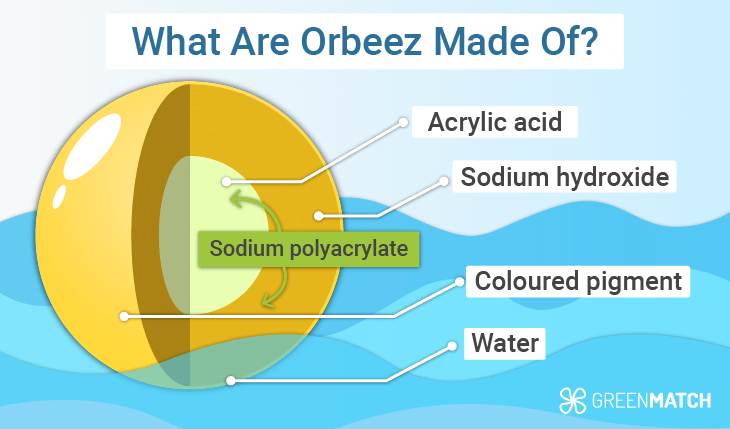
What is so bad about Orbeez for the environment?
Orbeez are made from a superabsorbent polymer that can soak up and hold onto large quantities of water. Due to these polymers, Orbeez are considered harmful to the environment, as they take a very long time to break down naturally.
One significant issue to consider is the emission of acrylamide, which was recently found within water beads. Acrylamide is considered to be a carcinogen, which has the potential to seep into the ground and water bodies, creating hazards for both people and animals.
Ecological impact

Orbeez can persist in the environment for years, posing potential risks to wildlife and aquatic ecosystems. Animals might ingest them, leading to internal blockages or other health issues, threatening species numbers.
While Orbeez can be safely disposed of with household waste (where they're likely to end up in landfills), they can take hundreds of years to break down naturally and, therefore, contribute to the growing problems of pollution.
Fish and other marine animals may mistake Orbeez for food, leading to ingestion that can be harmful or even fatal. Additionally, the accumulation of these non-biodegradable beads in waterways can disrupt natural water flow and affect the habitats of aquatic organisms.
Orbeez cause a lot of concern regarding their disposal method and potential to end up in our waterways. Below are some of the main issues related to Orbeez pollution.
Microplastic pollution
When Orbeez end up in natural water bodies like rivers, lakes, or oceans, they can break into smaller particles over time. These ‘microplastics’ (or micro polymers) are difficult to remove from the environment. They can be ingested by aquatic organisms, potentially entering the food chain and causing harm to wildlife and ecosystems. Microplastic pollution has been widely documented in scientific research as a significant source of damage to our water systems.
Microplastics are also a concern to human life. The UN estimates that ‘humans ingest a credit card worth of plastic per week!’ - which is shocking to learn, particularly as microplastics can cause various risks to human health. These include:
-
Digestive issues:
Physical irritation to the gastrointestinal tract leads to inflammation and various symptoms. They can also disrupt the intestinal microbiome, causing an imbalance between beneficial and harmful bacteria. Microplastics, when ingested, can lead to nausea, vomiting, and abdominal pain.
-
Breathing problems:
Inhaling microplastics can cause respiratory symptoms like coughing, sneezing, and shortness of breath. Exposure to nano-sized plastics can increase the risk of chronic obstructive pulmonary disease (COPD).
-
Endocrine issues:
Microplastics can interfere with hormone production, release, transport, metabolism, and elimination in the body.
-
General health:
Studies have shown that microplastics can cause oxidative stress, DNA damage, organ dysfunction, metabolic disorders, immune responses, neurotoxicity, reproductive issues, and developmental toxicity in humans. Epidemiological evidence suggests a link between microplastic exposure and chronic diseases.
Potential for ingestion by wildlife
Orbeez and similar SAPs can be mistaken for food by wildlife. If ingested, they can cause internal blockages or other animal health issues. This affects individual animals but can also have broader ecological impacts, disrupting food chains and harming biodiversity.
Clogging waterways
Large quantities of Orbeez, if disposed of incorrectly, could clog drainage systems and water treatment facilities. While this form of "pollution" might be less about chemical contamination, it poses a practical challenge for water management infrastructure, potentially leading to water quality issues or flooding.
Are Orbeez biodegradable?
When researching this point, you will often find many contradictory answers. Our research found that technically - yes, they can biodegrade. This issue lies in the rate at which this happens.
One study by Environmental Science and Pollution Research International (2014) identified that sodium acrylate has a potential decay rate of just 0.12% - 0.24% every 6 months. Further interpretation of these results estimates that it could take between 208 to 416 years for Orbeez to decay by half.
We estimate that without intervention, an Orbeez ball made of the standard material of polyacrylate polymer will take hundreds of years to completely degrade into its fundamental components.
In comparison to other items, this is a very slow decomposition rate. In addition, water beads are likely to end up in landfills, as they are not a recyclable product, and the conditions in landfills are not favourable to a quick breakdown. This is why so many commentators consider Orbeez to be non-biodegradable.

Sodium acrylate is also used in many other products - such as nappies, detergents, sanitary items, cleaning products and soaps. Cosmetics company Lush has recently addressed concerns about using this ingredient in their products:
Sodium polyacrylate will degrade, but the process can be very slow if the landfill doesn’t contain enough water or is not properly aerated. Because it is not only used in a few cosmetics but in a wide range of products [...] its impact on the environment has been questioned lately.
Due to its ability to trap moisture, this material makes a great addition to cosmetic products - to condition the skin and solidify products. As the research and evidence are still being gathered, Lush has committed to undertake “further research and testing to explore the action of this material on the environment” and is “working on finding a suitable substitute in case the information is not favourable”.
Are Obeez made from plastic?
Despite some confusion across the web, water beads are not technically made from plastic. They are made from a polymer, and whilst the term ‘polymer’ can be used to describe plastic, not all polymers are plastics (confusing, but it’s all about the science and different cell structures) - polymers can exist in nature or be made synthetically.
There are two types of polymers: synthetic and natural. Synthetic polymers are derived from petroleum oil, and made by scientists and engineers. Examples of synthetic polymers include nylon, polyethylene, polyester, Teflon, and epoxy. Natural polymers occur in nature and can be extracted. They are often water-based. Examples of naturally occurring polymers are silk, wool, DNA, cellulose and proteins.
It’s easy to see why Orbeez are often referred to as a plastic product because they are similar. In addition, the extraordinary amount of time it takes them to decompose is similar (if not worse!) to most plastic pollution.
As the United Nations points out, ‘Plastic waste can take anywhere from 20 to 500 years to decompose, and even then, it never fully disappears; it just gets smaller and smaller.’ We already know that Orbeez could take over 400 years to decompose by half, meaning their impact on the planet may be even greater than standard plastic waste.
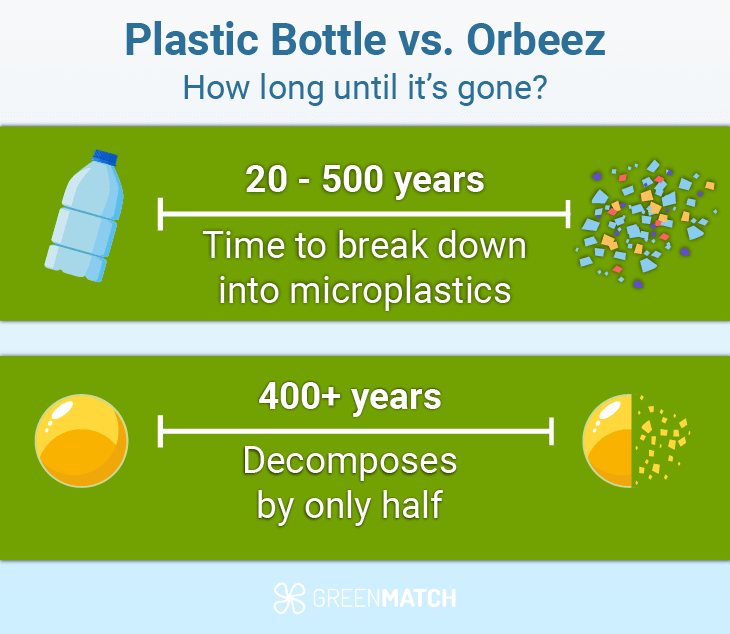
Are Orbeez sustainable?
In their current form, Orbeez are not considered a sustainable product. Most Orbeez and water bead products are made from superabsorbent polymers, produced using non-renewable fossil-based resources (such as petroleum).
Sodium polyacrylate (Na-PA) is a superabsorbent polymer, which is commonly used in diverse hygiene products. The polymer is currently produced from fossil feedstock, and its production consequently leads to adverse environmental impacts. Na-PA production from sugars present in pulp mill side streams can potentially be a successful way to achieve a more sustainable production of this polymer.
Due to the widespread applications of sodium polyacrylate (Na-PA), studies and trials are ongoing to find a more eco-friendly way to produce this polymer. This includes looking into existing biological processes that can recreate Na-PA.
When it comes to Orbeez, however, they do have one saving grace - they are made to be reused repeatedly. They can be dehydrated and rehydrated multiple times without losing their functionality, which means they can have a longer lifespan than single-use products.
Are Orbeez a health risk?
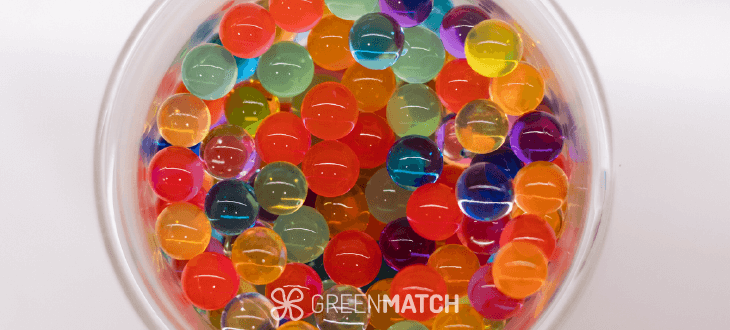
Aside from the risks of pollution after use, there are also risks associated with Orbeez during play.
You can find numerous studies online assessing the risks associated with Orbeez (or SAPs), particularly in children (their target audience). Most studies look into the dangers of swallowing or inserting the tiny, dehydrated balls into the mouth, ears, and nose, particularly as ingesting a material that expands upon contact with water poses serious health risks.
Various incidents have sparked the need for studies, including reports of over 100 cases of ingestion and the product recall of a similar water bead product in the U.S. in 2012. There are also reports of hearing complications after SAP beads enter the ear canal.
One of these studies concluded that:
Orbeez beads are commonly ingested by young children, resulting in gastrointestinal obstruction. The beads can easily be aspirated by children and overlooked by their caregivers and physicians for long periods of time due to their small size. The bead can cause significant airway damage after multiplying in size when coming into contact with respiratory mucus, which consists of 95% water.
As recently as November 2023, there have been calls from government officials, public health professionals and parents in America to ban water bead toys. Their concern is that many of these products, which can be bought in multiple stores and online, often don’t come with any safety warnings and can be easily picked up or found by children.
The Consumer Product Safety Commission (CPSC) in America claims these beads can be life-threatening to babies and young children. Concerns are that they may need to be removed through surgery when ingested. Furthermore, these beads have caused nearly 7,800 emergency room visits since 2016 - 2022 in the U.S. alone.
According to reports, the CPSC has recalled numerous water bead toys due to choking hazards, and in one case, 52,000 items were recalled after the death of a 10-month-old baby and the surgery of a 9-month-old, who had both swallowed the beads. Other reports have shown infants poisoned by the beads after being undetected in their bodies for months.
In addition, a recent study by the CPSC found that water beads can contain acrylamide, a known cause of cancer. When ingested, this harmful chemical can enter the body over time, leading to greater long-term health risks.
These are just a few examples from across the U.S., but the full extent of the safety risks to children from these products is unclear, as they are sold under different brand names and stores worldwide.
Are Orbeez toxic?
Orbeez are generally considered non-toxic, as their main component ingredients are non-toxic substances. Care should be taken, however, to ensure that any young children are supervised during use, as any ingestion or insertion into the body can cause serious health problems.
Official advice from Obeez manufacturers states:
Spin Master maintains rigorous quality control in its production, carefully controlling both the physical size and chemical makeup of Orbeez. Orbeez have undergone extensive testing and risk analysis by independent, third-party laboratories. All genuine Orbeez are non-toxic, do not clump and are expected to break down in gastro fluid. As with any foreign object, however, if a substantial number of Orbeez are swallowed, we advise consumers to seek immediate medical attention for the advice of a medical professional. The recommended age for Orbeez is for children ages 5+. Caregivers should carefully supervise children using Orbeez and should always store Orbeez away from small children.
Orbeez are considered safe and non-toxic for their intended uses but come with precautions. Always follow the recommended guidelines for use and disposal to ensure safety for all users and the environment.
Can you recycle Orbeez?
Orbeez cannot be recycled traditionally, as they don’t fit our conventional recycling methods - e.g. they can not be reshaped or repurposed. They can, however, be re-used multiple times.
Once a water bead has been used, it can dry out and return to its original small, pellet-like form. This can then be taken and re-absorbed in water to watch it expand again.
Official owners, Spin Master recommend replacing the product if you smell or detect mould, and you can keep them fresh by washing hands and feet before play. You can also lengthen their lifespan by storing them in a closed container, out of direct sunlight, between uses.
Can you get rid of Orbeez?
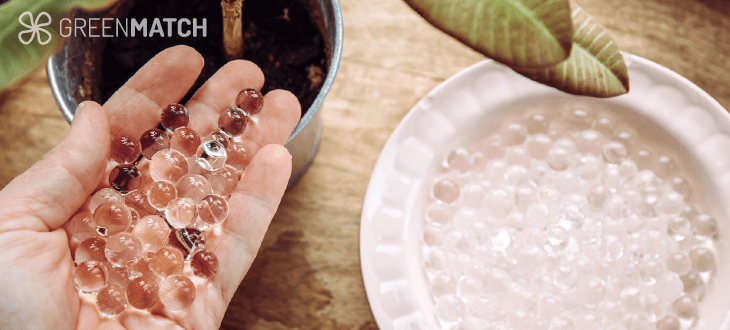
Yes, the recommended way to get rid of Orbeez is to throw them in the bin. We know, however, that this can end up in our landfills or, worse, in our waterways. To prevent this, you can consider other options for reuse.
For example, you could put them into potted soil to help keep your plants hydrated or pop them in a vase with flowers. You can also wait for them to dry out and store them for later use.
It’s important not to put Orbeez down the drain (or the toilet!) as they can block pipes. (Remember that Orbeez can get very large if submerged in liquid for a long time). This can also harm wildlife if it ends up in our waterways further down the drainage system.
What are Orbeez alternatives?
If everything you’ve learned about Orbeez so far has you feeling quite concerned, why not think about switching your toys to a more eco-friendly, sustainable alternative that’s safe for kids?
Many great parenting blogs offer homemade, safe and equally fun alternatives. Here are some examples we found:
-
Basil or chia seeds
This idea is great because it uses small, edible seeds to avoid choking hazards.
To use these, mix 1 tbsp of seeds with food colouring and water and let them soak.
This idea is great because it creates a safe, edible alternative that is just as colourful, bead-like and fun to explore for little ones - although a little bit sticky.
There are also fewer environmental implications using a food product because you can compost these after use. (Source: Fun at Home with Kids)
-
Tapioca balls
These are great for the littlest kids who still taste-test everything. You would find tapioca balls in boba tea - and they are edible. They need to be cooked, but they look a lot like Orbeez once done! You can also add food colouring to make them more vibrant.
The only thing to consider is that these will be more sticky than Orbeez, but this can add to the sensory experience! (Parenting Chaos has some excellent images of how these can turn out).
-
Sensory play
Other ideas offering a similar sensory experience include sand, homemade playdough, or a cornstarch and water mix. Each can be enjoyed without concerns for their environmental impact, made from natural products and child-safe.
Statistics, facts and figures about Orbeez
- When exposed to liquid, Orbeez can expand to 100 times their initial size and weight, according to the Consumer Product Safety Commission.
- Since 2016, nearly 8,000 visits to A&E have resulted from Orbeez or water bead incidents in America.
- In the U.S. there have been reports of small infant deaths and poisoning from ingestion of water bead products. As a result, a bill is being put to Congress to ban these products.
- Orbeez are made of a superabsorbent polymer, sodium polyacrylate, which can absorb up to 300 times its weight in water.
- The technology behind Orbeez was originally developed for agricultural purposes to help soil retain moisture for plants more efficiently.
- Orbeez do not biodegrade quickly; they can take hundreds of years to degrade in the environment, contributing to concerns about microplastic pollution.
- Orbeez are not recyclable due to their composition of superabsorbent polymers and therefore contribute to landfill mass.
- While Orbeez cannot be recycled, they are reusable multiple times until they break down. They can be dried and rehydrated repeatedly.
- Recognising the environmental concerns associated with Orbeez, there has been a push towards finding biodegradable alternatives and promoting more sustainable options for sensory play - these can include using tapioca balls or basil seeds instead.
- Over two years, from September 2021 to July 2023, packs of water beads were purchased approximately 3.4 million times (via Amazon), indicating a substantial consumer demand.
- Superabsorbent polymers have been used since the 1950s and 1960s, initially developed for agricultural purposes such as water storage for plants and crops. Over time, these materials found applications in consumer goods such as nappies, sanitary products, and decorative fillers for florists.
Frequently asked questions about Orbeez
Some studies estimate it could take over 400 years for an Orbee to degrade by half, suggesting full decomposition could be close to 1,000 years or more!
They should be put in the household waste bin, but never put down drains, toilets or plug holes as they can expand and cause blockage – or worse, impact on wildlife if they reach waterways.
Due to their slow decomposition, Orbeez can shed tiny particles of polymer over time into soil and water. This is considered a form of microplastic which can have a detrimental impact on animal and human health.
Left in dry conditions, they will dehydrate and return to their original size. They can expand up to 100 times their size in wet conditions. It’s important not to leave Orbeez unattended due to the health and safety risks to small children and wildlife.
Whilst they are non-toxic, in their non-hydrated state, they can be fatal if ingested or inhaled by children or animals. It’s important to store Orbeez in a safe container when not in use.

Becky is an experienced SEO content writer specialising in sustainability and renewable trends. Her background in broadcast journalism inspires reliable content to help readers live more sustainably every day.
We strive to connect our customers with the right product and supplier. Would you like to be part of GreenMatch?

- What do we mean by Orbeez exactly?
- Environmental impact of Orbeez
- What are Orbeez made of?
- Ecological impact
- Are Orbeez biodegradable?
- Are Obeez made from plastic?
- Are Orbeez Sustainable?
- Are Orbeez a health risk?
- Are Orbeez toxic?
- Can you recycle Orbeez?
- Can you get rid of Orbeez?
- What are Orbeez alternatives?
- Statistics, facts and figures about Orbeez
- Frequently asked questions about Orbeez




